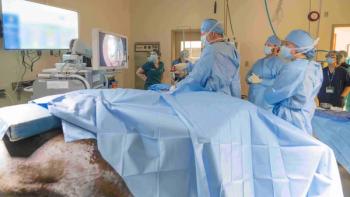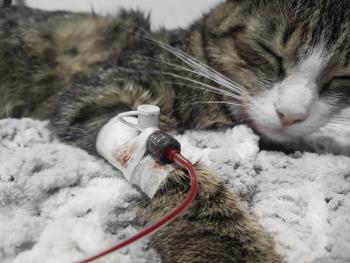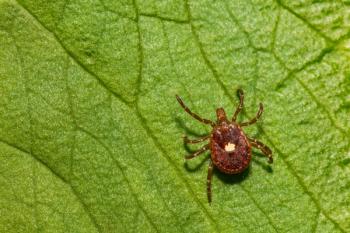
Feline nightmare case number two: A 15-year-old cat with profound weakness and azotemia (Proceedings)
We had initially made a tentative diagnosis of chronic renal failure with secondary hypertension, dehydration and electrolyte loss, but did not know the cause of the hindlimb weakness.
Signalment: 15-year-old female spayed DLH cat
History
• One-day of lethargy, anorexia, and inability to use the hind legs.
• One-year history of PU/PD
• Diet of Fancy Feast
Physical Exam
• T = 99F, P = 148 bpm, R = 36 rpm
• III/VI left parasternal murmur
• L kidney > R kidney
• Profound weakness in rear limbs
• Motor activity present
• Cranial nerves normal
• Non-painful, femoral pulses OK, toes pink
CBC
• Hct = 27%
• Normocytic, normochromic
• 60,700 retics
Systolic blood Pressure = 160 mmHg
Urinalysis
• USG = 1.016
• pH = 6
• Protein = 100
• Glucose =100
• Quiet sediment
Serum Chemistry
• Creatinine = 350 uM/L mg/dl (90 – 210)
• BUN = 64.1 mg/dl (14 – 34)
• Globulin = 62 g/L (26 – 51)
• Albumin = 43 g/L (27 – 38)
• Phosphorus = 2.8 (0.8 - 3)(0.7-2.6)
• Potassium = 2.7 meq/L (3.8 – 5.4)
• Glucose = 16 mM/L
• Total T4 = 31.5 nmol/L (17 - 49)
Summary of Results
• Azotemia
• Panhyperproteinemia
• Hyperglycemia
• Hypophosphatemia
• Isosthenuria
• Proteinuria
• glycosuria
Questions
1) If this is renal azotemia with dehydration, why is the phosphorus low?
2) What's the reason for the hind limb weakness?
3) Is this cat diabetic?
Subsequent developments
• Intravenous LRS + 24 mEq/L KCL given
• Increased respiratory effort developed over ensuing 8 hours
• Progressed to cyanosis, HR of 88 bpm, temp of 92.7F
• EKG showed only bradycardia and occasional VPC
Recheck of some values
• Sodium = 154 mEq/l
• Potassium < 2 mEq/L
• Venous pH = 6.887
• Base excess = -11mmol/l
• pCO2 = 115 mmHg
Assessment
• Mixed acidosis
• Hypoventilation
• Worsening hypokalemia
• Hypernatremia
Our Plan
• Anesthesia and Positive Pressure Ventilation
• Active warming
• KCl infusion
• EKG, temp, blood pressure, pulse ox, and end tidal CO2 monitoring
One Hour Later . . . .
• O2 saturation declines to 90%
• Muffled lung sounds
• Thoracocentesis yielded 300 ml air
• Arterial Blood Gases on 100% O2
• pH = 7.125
• pCO2 = 42.1 mmHg
• pO2 = 144 mmHg
• Bicarb = 14 mEq/l
• Base excess = -15 mmol/L
We had initially made a tentative diagnosis of chronic renal failure with secondary hypertension, dehydration and electrolyte loss, but did not know the cause of the hindlimb weakness. Hyperglycemia in this cat may have been due to diabetes mellitus, which was consistent with the polyuria, polydipsia, glycosuria and proteinuria, however stress hyperglycemia could not be ruled out. Initial treatment involved intravenous fluid therapy, but within 8 hours of admission the cat's clinical status had deteriorated. She developed respiratory distress, and electrolye and venous blood gas analysis revealed mild hypernatremia (sodium 154 mEq/L), severe hypokalemia (potassium < 2mEq/L) and a marked mixed acidosis (pH 6.887, pCO2 115 mmHg, base excess –11 mg/dL). Arterial blood gas analysis performed after thoracocentesis (FiO2 100%) showed pH 7.125, pCO2 42.1 mmHg, pO2 144 mmHg, bicarbonate 14 mmol/L, base excess –15 mmol/L and SO2 98%, indicating metabolic acidosis and relative hypoxemia despite positive pressure ventilation. The acidosis was most likely due to decreased oxygen delivery to tissues secondary to hypoperfusion and hypoxemia with production of acid in anaerobic glycolysis. When the pneumothorax continued and the cat declined further, the owners elected euthanasia.
The gross necropsy findings showed a right adrenal gland tumor. Both kidneys were abnormal, but consistent with chronic disease. A lung tumor was also found, and. the pneumothorax may have been due to parenchymal rupture secondary to increased pressure on weakened pulmonary tissue due to the focal lung mass. On histopathology, the adrenal mass was interpreted as a cortical adenoma. The kidneys had interstitial inflammation and membranous glomerulonephritis with glomerulosclerosis and medullary tubular mineralization. We measured the concentration of aldosterone on a banked serum sample. The resting serum concentration of aldosterone was > 3329 pmol/L, consistent with hyperaldonsteronism
Primary hyperaldosteronism is a rare disorder in cats. Although not reported with primary hyperaldosteronism, profound hypokalemia has been associated with respiratory failure in clinical studies of cats. The progressive clinical signs in this cat, from weakness and lethargy to acute respiratory failure, were exacerbated by the initial treatment. The ventilatory failure may have been due to an acute decrease in the serum potassium concentration and intravenous fluid therapy may have exacerbated potassium loss by increasing glomerular filtration rate and delivery of potassium to the distal tubule, where the effects of aldosterone would further enhance potassium excretion. Hypokalemia develops when there is depletion of total body potassium stores or when extracellular potassium is redistributed into cells. Redistribution of extracellular potassium may occur with insulin administration or with a metabolic alkalosis. Decreased potassium intake may occur with inappetance. Potassium loss occurs with most commonly through the kidneys. Osmotic diuresis, diuretics, renal tubular acidosis, and, as in this case, hyperaldosteronism can be the underlying causes of renal potassium loss.
Aldosterone secretion is influenced by serum potassium and renin concentrations. Aldosterone enhances sodium retention and facilitates potassium excretion in the kidney. Clinical signs of hyperaldosteronism are due to sodium retention, and include polyuria, polydipsia and hypertension.
References
Reports cats with hypokalemia associated with aldosterone-secreting adrenal tumors are rare. This case was reported in the Journal of Veterinary Emergency and Critical Care. For complete information on this case, please see:
Haldane S, Graves TK, Bateman S, Lichtensteiger CA. Profound hypokalemia causing respiratory failure in a cat with hyperaldosteronism. J Vet Emerg Critical;17(2):202-207, 2007
Newsletter
From exam room tips to practice management insights, get trusted veterinary news delivered straight to your inbox—subscribe to dvm360.




